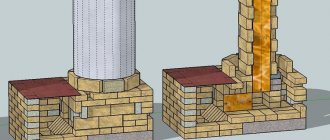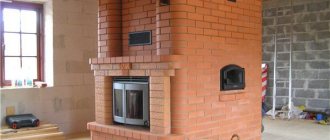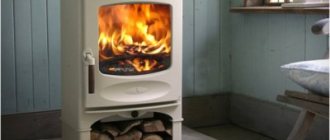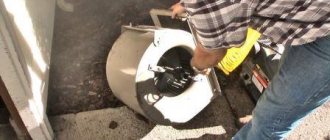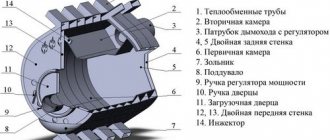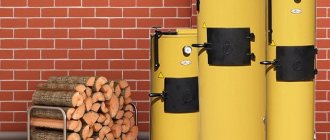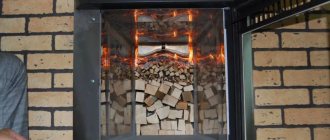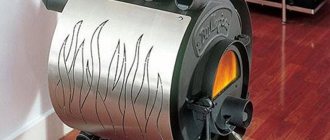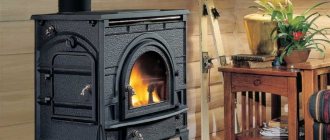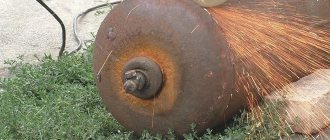Long-burning stoves The Buleryan heating device was first developed for the needs of Canadian lumberjacks, who used it to heat their homes. Over time, this type of heating device has become widespread in other countries. In Russia it is known as the “oven from Canada”, or Breneran, as well as Bullerian. The design of this device is simple, and many people can install the Buleryan stove with their own hands without much difficulty.
Positive and negative aspects of the device
Breneran is a successful design that runs on solid fuel. It has many advantages:
- The housing serves as a forced convector through which all the oxygen in the room passes. In this case, air exchange is carried out naturally - due to the different densities of heated and cool air.
- You can burn peat briquettes, logs, waste from the paper and woodworking industries.
- High efficiency of the stove - it reaches 80%.
- Drawings of this heating device are widespread and can be found without much difficulty on the World Wide Web.
- The materials and equipment for installing the product are quite simple and are not very expensive. You will need a welding machine, a pipe bending device, metal sheets and stainless steel heat exchangers.
- The installation of the equipment itself, as well as the principle of its operation, is quite simple.
Disadvantages of the design
Buleryan has no visible negative sides. These devices are called “furnaces without flaws.” But if you understand the design well, you can still find negative aspects:
- Burning coal in a stove may damage the device. The use of flammable liquids and gases is also prohibited.
- The operating principle is based on the combustion of wood and paper. In this case, reaction water is released, which is formed during the breakdown of molecules of living organisms.
Modern design
Sellers, when advertising Breneran, say that when burning, wood does not form ash, but it is present in the wood initially. Therefore, ash particles fly into the chimney pipe.
When organic matter decomposes, hydrocarbon radicals are released, which reduce the efficiency of the stove by 6%. This is a small number, but radicals are quite dangerous for heating devices in everyday life.
The resulting water after the reaction precipitates as condensate. Moreover, this is not just a contaminated liquid, but a mixture of ash particles and a thin film rolled into a lump. The resulting toxins fall into the sump and have an unpleasant odor. This “water” always needs to be taken out somewhere, because it cannot be poured into the garden - otherwise the soil will be poisoned. In connection with this not very pleasant phenomenon, a heating device is often used in greenhouses, where the soil must be renewed annually.
Helpful operating tips
“Incorrect” installation of chimney pipes is due to the need to protect the structure from resin, which is formed as a result of the combustion of wood. If this moment is not provided for, then the resin will flow out of the stove, and with such an installation it will remain in the chimney and gradually burn out.
Upon completion of assembly, the Buleryan stove is installed on a flat and fire-resistant base and connected to the chimney. In this case, it is necessary to comply with fire safety rules
Clogging with resin for the Buleryan stove is almost inevitable. Over time, resinous layers accumulate and clog the device. This is expressed in a noticeable reduction in the efficiency of its operation, a decrease in traction, and problems with the free movement of the gate. So it's time to start cleaning the oven.
A lightweight version of this cleaning is to heat the device with aspen firewood. Unfortunately, the practical benefits of such a measure are small and short-lived.
The best way to eliminate resin contamination is burning. To do this, the stove is heated strongly with the ash pan open, essentially calcining all the channels. As a result, the resinous deposits burn out.
Based on the Buleryan stove, you can organize an autonomous heating system:
Image gallery
Photo from
Burelyan as the basis for autonomous heating
Air heating basis
Connecting their corrugated air ducts to the furnace pipes
Water heating device
Some craftsmen use oxygen to burn the furnace, bringing the nozzle of the cylinder to the opening of the ash pan. This is an extremely dangerous operation that violates fire safety regulations. Careless handling of an oxygen cylinder near an open flame may cause an explosion.
As fuel for the Buleryan stove, you can use not only firewood, but also wood waste (shavings) or special briquettes. An important condition is low fuel moisture. The less moisture, the less resin is formed inside the stove, and the less often it will have to be cleaned.
During operation of the furnace, you need to select an operating mode in order to obtain maximum heat with minimal resin formation. If the best option is found, cleaning will only need to be done a couple of times during the heating season.
Unit design
Device diagram
The product is based on the diagram of a steel convection-tube air boiler of slow combustion. Sometimes it is called a furnace-heater type device.
Buleryan consists of the following parts:
- Fireboxes. Heat exchangers are recessed into its walls by 2/3 of the diameter. In this case, 70% of the heat released in the firebox during smoldering is transferred from the air to the tubes. And 10% is distributed throughout the oven and heats the air.
- Doors that close tightly.
- Blower type pipe.
- Throttle. Using it, you can regulate the power of the device, and when it is closed, the oven goes out.
- Grate bars made of cast iron. When installing the product, they are placed below at a level slightly more than half of the firebox.
- Partitions located horizontally. It is welded from the top to a quarter of the height of the firebox and at the same time reaches the front side by a fifth of the entire size of the firebox. This jumper has holes with a total area of 7%.
Principle of operation
Schematic diagram
When the unit is operating, oxygen for afterburning is taken from the combustion chamber. In this case, the proportion of air that is taken from the firebox changes mechanically. Its quantity depends on the quality of the fuel used and the set combustion mode. This distinguishes Buleryan from all systems with connected or separate air flows.
The space separated by an upper partition forms an afterburning chamber when operating in smoldering mode. Flue gases from the afterburner are discharged into a “hog” or “pig”. This part of the chimney is placed horizontally, and its length is 0.8–1 m. The use of a hog is mandatory, since it slightly stops the combustion of the gases that escape.
In the chimney after turning there is a damper, or smoke choke. There is no view that completely blocks the chimney, so there is no danger of burning. The diameter of the chimney is slightly larger than the blower pipe, and a hole is made in the damper, so carbon monoxide will in any case go into the chimney pipe. An economizer is located on top of the gate in the furnace.
Element names
Having studied the drawing of the buleryan, you can see that its structure is a vertically located section of the chimney. Its length is from 1.5 to 3 m. The final combustion of fumes occurs in it. In the hog, the middle of the gas stream does not have time to cool, and the IR reflected from the walls of the economizer increases the concentration of thermal energy in the flow, so a gas flash occurs.
The gas that has flared up increases in volume, but in a closed space it has nowhere to go, so a gas lock is formed. In this case, the combustion in the furnace firebox subsides, the plug cools and passes out, and the combustion intensifies again.
Important! The heating device can operate without an economizer. Only in this case, the efficiency drops from 80% to 60%, and the device fails after 2–3 years. Therefore, this operating principle is impractical.
Manufacturing of the Buleryan stove and its installation
Homemade version
For accurate installation of the stove, you must have drawings with strictly specified dimensions and all technical characteristics of the product. If the structure deviates from the dimensions when welding, it may become “skewed”, and money will be wasted on purchasing materials.
Installation is carried out on a frame made of metal corners or pipes 25 cm high, so it is recommended to carry out installation directly on it. You can combine the frame with the firebox. To do this, you need to take a metal pipe with a diameter of 40–60 cm and a length of 50–70 cm. Another option is possible. When using it, you do not need a blank for the body. It can be made from duct-type pipes. The firebox will be assembled from different steel sheets.
The assembly diagram for the Buleryan stove requires the following components:
- Steel plates. Their thickness is 2 mm and 10 mm.
- Steel pipes. Their wall thickness is 3 mm, outer diameter is 45–50 mm, quantity is 9 pieces, length is up to 1.5 m.
- Doors for the firebox are round in shape and have hinges for it. Please note that the firebox diameter is 25 cm.
- Two tubes for the gas afterburning sector. Their diameter should be 12–16 mm.
- Damper type plates that are used to regulate air supply.
When making a stove, the blowers are bent at 80 degrees, then they are placed on the frame and firmly secured so that they do not move or fall. This is usually done by welding temporary metal strips on the inside. Then the heat exchangers are assembled into one unit by welding using metal strips, the width of which is 5–6 cm. After this installation, a barrel-shaped body will be obtained, with the pipes arranged oppositely. We remove temporary strips.
Design similar to the original
The drawings provide for a combustion chamber. After installing it, weld the steel plate. It is necessary to put firewood on it. Next, a steel circle 2 mm thick is made, inside which a hole with a diameter of 120 mm is made. The circle is attached and serves as the back wall. A chimney socket is installed in the hole. Then a gate is inserted inside it, which is held in place by a spring and a lever handle.
Now it is necessary to equip a place where the gases are burned. In the upper part, a strip is attached to form the second floor, and two tubes with a diameter of 12 mm are welded above it.
We assembled all the main parts with our own hands, and now we need to install the firebox doors. A steel circle with sides is attached to the front of the stove. It is on this that the door will be placed. It is necessary to provide the same protrusion on it.
To regulate the air flow in the firebox door, a hole with a diameter of 60 mm is cut out and a steel tube is welded into it. A pipeline is attached to the chimney socket, which after installation will be higher than the roof ridge. During installation, the outside of the chimney pipe must be well insulated, otherwise condensation will form.
Scope of application of furnaces
Wood stoves have proven themselves to be excellent in heating commercial buildings (greenhouses, workshops, garages). Buleryans can also be used as an alternative backup heating system in a private residential building. For example, they are useful during the off-season, when weather conditions force the room to be warmed up for a short time.
In severe frosts, such stoves can help maintain a comfortable temperature in the house, significantly lightening the load on the central heating system. This is an excellent option for a dacha if you plan to come there periodically, but at different times of the year. In this case, it makes no sense to equip serious heating communications.
Buleryan is the best choice for quickly and easily solving a problem with heating a house. In addition, these stoves are distinguished by their unique beauty and, in addition to their main functions, can become an original and unusual element that allows you to customize the interior of the room.
Buleryan stoves are inexpensive and easy to purchase, or you can even make them yourself. Installation of such heating devices is extremely simple, and if desired, you can do it yourself. You just need to determine and properly equip the place for the stove, install the unit and connect it to the chimney.
You may also be interested in an article on how to make a diesel drip stove with your own hands: //6sotok-dom.com/dom/otoplenie/pech-kapelnitsa-svoimi-rukami.html
